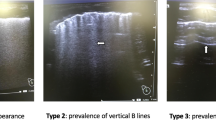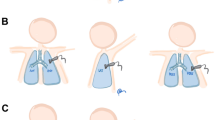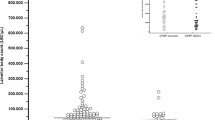Abstract
With the advent of surfactant replacement therapy, there is an increasing need for a rapid test of predicting the development of respiratory distress syndrome (RDS). We evaluated the clinical usefulness of the stable microbubble (SM) test in predicting the development of RDS by comparison with other tests in amniotic fluid samples obtained within 12h before delivery from 40 pregnancies between 23–35 weeks of gestation. These tests included the lecithin/sphingomyelin (L/S) ratio, disaturated phosphatidylcholine/sphingomyelin (DSPC/S) ratio, concentrations of lecithin, DSPC, and surfactant-associated proteins A and B, C (SP-A, SP-B,C). The cut-off value of each test for predicting RDS was determined at a point of maximum diagnostic accuracy. The overall diagnostic accuracy of the SM test was similar to that of other tests. However, both the SM test and the SP-B,C concentration had positive predictive values of 100%. We conclude that the rapid (<10 min) and reliable information obtained by this test should encourage its use in defining a population of neonates with surfactant deficiency in a multicentre trial of prophylactic surfactant therapy.
Similar content being viewed by others
Abbreviations
- RDS:
-
respiratory distress syndrome
- L/S ratio:
-
lecithin/sphingomyelin ratio
- DSPC:
-
disaturated phosphatidylcholine
- DSPC/S ratio:
-
disaturated phosphatidylcholine/sphingomyelin ratio
- SP-A:
-
surfactant-associated protein A
- SP-B,C:
-
surfactant-associated protein B, C
- SM:
-
stable microbulbble
References
Armitage P (1971) Statistical methods in medical research. Blackwell Scientific Publications, Oxford, pp 127
Bhagwanani SG, Fahmy D, Turnbull AC (1972) Prediction of neonatal respiratory distress by estimation of amniotic fluid lecithin. Lancet I:159–162
Chida S, Phelps DS, Cordle C, Soll R, Floros J, Taeusch HW (1988) Surfactant-associated proteins in tracheal aspirates of neonates with respiratory distress syndrome after surfactant therapy. Am Rev Respir Dis 137:943–947
Chida S, Fujiwara T, Takahashi A, Kanehama S, Kaneko J (1991) Precision and reliability of stable microbubble test as a predictor of respiratory distress syndrome. Acta Paediatr Jpn 33:15–19
Chida S, Fujiwara T, Konishi M, Takahashi H, Sasaki M (1992) Stable microbubble test for predicting the risk of respiratory distress syndrome: II. Prospective evaluation of the test on amniotic fluid and gastric aspirate. Eur J Pediatr 152:151–155
Clements JA, Platzker ACG, Tierney DE, Hobel CJ, Creasy RK, Margolis AJ, Thibeault DW, Tooley WH, Oh W (1972) Assessment of the risk of the respiratory-distress syndrome by a rapid test for surfactant in amniotic fluid. N Engl J Med 286: 1077–1081
Fujiwara T (1984) Surfactant replacement in neonatal RDS. In: Robertson B, Van Golde LMG, Batenburg JJ (eds) Pulmonary surfactant. Elsevier, Amsterdam, pp 479–503
Fujiwara T, Takahashi H (1989) Assessment of fetal lung maturity: stable microbubble test in amniotic fluid and gastric aspirate. J Jpn Med Assoc 101:281–288 (in Japanese)
Gluck L, Kulovich MV, Borer RC, Brenner PH, Anderson CG, Spellacy WN (1971) Diagnosis of the respiratory distress syndrome by amniocentesis. Am J Obstet Gynecol 109:440–445
Gonen R, Tal J, Oettinger M, Samberg I, Sharf M, Yechieli H, Boxer J (1978) Assessment of fetal lung maturity by a microviscosimeter. Obstet Gynecol 51:422–425
Hallman M, Teramo K (1981) Measurement of the lecithin/sphingomyelin ratio and phosphatidylglycerol in amniotic fluid: an accurate method for the assessment of fetal lung maturity. Br J Obstet Gynaecol 88:806–813
Hallman M, Kulovich M, Kirkpatrick E, Sugarman RG, Gluck L (1976) Phosphatidylinositol and phosphatidylglycerol in amniotic fluid: indices of lung maturity. Am J Obstet Gynecol 125:613–617
Hallman M, Merritt TA, Jarvenpaa A-L, Boynton B, Mannino F, Gluck L, Moore T, Edwards D (1985) Exogenous human surfactant for treatment of severe respiratory distress syndrome: a randomized prospective clinical trial. J Pediatr 106: 963–969
Hallman M, Arjomaa P, Mizumoto M, Akino T (1988) Surfactant proteins in the diagnosis of fetal lung maturity: I. predictive accuracy of the 35 kD protein, the lecithin/sphingomyelin ratio, and phosphatidylglycerol. Am J Obstet Gynecol 158: 531–535
Katyal SL, Amenta JS, Singh G, Silverman JA (1984) Deficient lung surfactant apoproteins in amniotic fluid with mature phospholipid profile from diabetic pregnancies. Am J Obstet Gynecol 148:48–53
King RJ, Ruch J, Gikas EG, Platzker ACG, Creasy RK (1975) Appearance of apoproteins of pulmonary surfactant in human amniotic fluid. J Appl Physiol 39:735–741
Kuroki Y, Takahashi H, Fukuda Y, Mikawa M, Inagawa A, Fujimoto S, Akino T (1985) Two-site “simultaneous” immunoassay with monoclonal antibodies for the determination of surfactant apoproteins in human amniotic fluid. Pediatr Res 19: 1017–1020
Mason RJ, Nellenbogen J, Clements JA (1976) Isolation of disaturated phosphatidylcholine with osmium tetroxide. J Lipid Res 17:281–284
McMahan MJ, Mimouni F, Miodovnik M, Hull WM, Whitsett JA (1987) Surfactant associated protein (SAP-35) in amniotic fluid from diabetic and nondiabetic pregnancies. Obstet Gynecol 70:94–98
Morita T, Fujiwara T (1984) Prediction of RDS by the measurement of DSPC/S in amniotic fluid. Jpn J Perinatal Med 9:757–763 (in Japanese)
Pattle RE (1955) Properties, function and origin of the alveolar lining layer. Nature 175:1125–1126
Pattle RE, Kratzing CC, Parkinson CE, Graves L, Robertson RD, Robards GJ, Currie JO, Parsons JH, Sutherland PD (1979) Maturity of fetal lungs tested by production of stable microbubbles in amniotic fluid. Br J Obstet Gynaecol 86:615–622
Shelley SA, Balis JU, Paciga JE, Knuppel RA, Ruffolo EH, Bouis PJ (1982) Surfactant “apoproteins” in human amniotic fluid: an enzyme-linked immunosorbent assay for the prenatal assessment of lung maturity. Am J Obstet Gynecol 144:224–228
Snyder JM, Kwun JE, O'Bien, JA, Rosenfeld CR, Odom MJ (1988) The concentration of the 35-kDa surfactant apoprotein in amniotic fluid from normal and diabetic pregnancies. Pediatr Res 24:728–734
Taeusch HW, Keough KMW, Williams M, Slavin R, Steele E, Lee AS, Phelps D, Kariel N, Floros J, Avery ME (1986) Characterization of bovine surfactant for neonates with respiratory distress syndrome. Pediatrics 77:572–581
Takahashi A, Fujiwara T (1986) Proteolipid in bovine lung surfactant: its roll in surfactant function. Biochem Biophys Res Comm 135:527–532
Torday J, Carson L, Lawson EE (1979) Saturated phosphatidylcholine in amniotic fluid and prediction of the respiratory distress syndrome. N Engl J Med 301:1013–1018
Whitsett JA, Ohning BL, Ross G, Meuth J, Weaver T, Holm BA, Shapiro DL, Notter RH (1986) Hydrophobic surfactant-associated protein in whole lung surfactant and its importance for biophysical activity in lung surfactant extracts used for replacement therapy. Pediatr Res 20:460–467
Author information
Authors and Affiliations
Rights and permissions
About this article
Cite this article
Chida, S., Fujiwara, T. Stable microbubble test for predicting the risk of respiratory distress syndrome: I. Comparisons with other predictors of fetal lung maturity in amniotic fluid. Eur J Pediatr 152, 148–151 (1993). https://doi.org/10.1007/BF02072493
Received:
Accepted:
Issue Date:
DOI: https://doi.org/10.1007/BF02072493




